2014 Top Ten
I struggled to settle on my selections for the list of my favorite film experiences of 2014. As is my usual practice, I tried to distinguish between a claim of personal affinity and the more nebulous claim of objective quality. In the past, that distinction has made things easier for me; after all, who can’t gauge his own response?
What made this particular list difficult to shape was that I had five films I was enthusiastic about and another twenty hovering on the plateau just below them.
Also, this was the first year that issues of release date complicated my choices–in part because last year was the first year I left films off my list (Can a Song Save Your Life?; Under the Skin) because they had not yet been distributed. Previously I had always figured that since this was my list, the criteria should be when I saw the particular film. Deciding to wait to include some films didn’t appear to be a bad idea, but I realize now that a further distinction needed to be made between films that I was confident would receive a widespread theatrical (or DVD) release and those whose distribution status was more murky.
Barring some unforeseen circumstance, it won’t be a problem to consider Love & Mercy next year. But what about films like Holbrook/Twain: An American Odyssey or Beginning With the End? Would they become this year’s versions of Jodorowsky’s Dune and Supermensch–films the never really entered the discussion because they floated through the long tail without ever really having their moment in the spotlight? What about The Clouds of Sils Maria and Phoenix, films that were well reviewed on the festival circuit but may not get a big studio push? Since most anything the studios think might get award consideration receives a qualifying theatrical run, I am comfortable with kicking the can down the road for studio films while going ahead and counting smaller films I saw at festivals. That’s inconsistent, I know, but as I said, it’s my list.
10) Get on Up — Tate Taylor
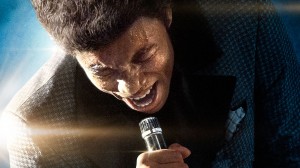 I watched Get on Up twice last year, and both times I had a similar experience. I was put off by the opening, enthralled by the middle, and impatient with the end. That is not exactly the sort of endorsement one expects on a Top 10 list, but when the film is on, it is very, very, good. Chadwick Boseman follows up a career-making performance as Jackie Robinson in 42 with a superlative one as James Brown here. (Yes, he made Draft Day in between, but who wants to hold that against him?) Get on Up refuses to make Brown nice by either watering down his aggressively anti-social behavior or overplaying (until the end) the psychological explanations for it. By also eschewing chronological order, it avoids the plodding pace of a film like Jersey Boys, which expected viewers to be surprised by revelations they had anticipated much earlier. Dan Ackroyd gives a wonderfully ambiguous turn as Ben Bart. The film also manages some genuinely funny moments. My favorite: Brown and his group get bumped from the status slot on the Ed Sullivan show in favor of some new group called The Rolling Stones. Instead of sulking, Brown blows the doors off and then leaves the stunned Stones to try to follow in his wake.
I watched Get on Up twice last year, and both times I had a similar experience. I was put off by the opening, enthralled by the middle, and impatient with the end. That is not exactly the sort of endorsement one expects on a Top 10 list, but when the film is on, it is very, very, good. Chadwick Boseman follows up a career-making performance as Jackie Robinson in 42 with a superlative one as James Brown here. (Yes, he made Draft Day in between, but who wants to hold that against him?) Get on Up refuses to make Brown nice by either watering down his aggressively anti-social behavior or overplaying (until the end) the psychological explanations for it. By also eschewing chronological order, it avoids the plodding pace of a film like Jersey Boys, which expected viewers to be surprised by revelations they had anticipated much earlier. Dan Ackroyd gives a wonderfully ambiguous turn as Ben Bart. The film also manages some genuinely funny moments. My favorite: Brown and his group get bumped from the status slot on the Ed Sullivan show in favor of some new group called The Rolling Stones. Instead of sulking, Brown blows the doors off and then leaves the stunned Stones to try to follow in his wake.
9) Holbrook/Twain: An American Odyssey — Scott Teems
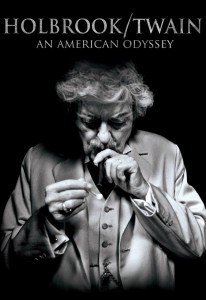 In 1983, I saw Hal Holbrook do Twain at The Kennedy Center in Washington, D.C. I was a junior in high-school and thought that it might be my last, best chance to witness an important piece of Americana. Flash-forward thirty-one years and Holbrook is still doing his show. One ivory tower academic interviewed in the film calls him the preeminent Twain scholar in the world. Twain could not have asked for a better avatar to keep his words alive. When I interviewed actor Sean Astin once, he claimed that characters leave their mark on actors every bit as much as actors leave a piece of themselves with their characters. If this is true–and I have no reason to think it isn’t–the effects of playing the same character over thousands of performances and several decades cannot be understated. Mark Twain hated hypocrisy; we like that about him when he is talking about politicians and other easy targets. One of the most fascinating aspects of Teems’s documentary is the way in which Holbrook engages in self-examination, shining the author’s hallmark dislike of hypocrisy onto his own life choices. Holbrook’s show has done more than keep interest in Twain alive. By taking his act into the segregated South in the sixties and behind the Iron Curtain, he has reminded us of art’s power to challenge and provoke us as well as to entertain. But always at a cost.
In 1983, I saw Hal Holbrook do Twain at The Kennedy Center in Washington, D.C. I was a junior in high-school and thought that it might be my last, best chance to witness an important piece of Americana. Flash-forward thirty-one years and Holbrook is still doing his show. One ivory tower academic interviewed in the film calls him the preeminent Twain scholar in the world. Twain could not have asked for a better avatar to keep his words alive. When I interviewed actor Sean Astin once, he claimed that characters leave their mark on actors every bit as much as actors leave a piece of themselves with their characters. If this is true–and I have no reason to think it isn’t–the effects of playing the same character over thousands of performances and several decades cannot be understated. Mark Twain hated hypocrisy; we like that about him when he is talking about politicians and other easy targets. One of the most fascinating aspects of Teems’s documentary is the way in which Holbrook engages in self-examination, shining the author’s hallmark dislike of hypocrisy onto his own life choices. Holbrook’s show has done more than keep interest in Twain alive. By taking his act into the segregated South in the sixties and behind the Iron Curtain, he has reminded us of art’s power to challenge and provoke us as well as to entertain. But always at a cost.
8) Begin Again — John Carney
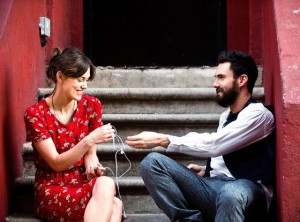 I adored John Carney’s film when it played at the 2013 Toronto International Film Festival. I didn’t even mind the original title: Can a Song Save Your Life? Not a lot of people shared that sentiment, so when the film was finally released on DVD after a short run in 2014, I approached a second viewing expecting to be chagrined at my original enthusiasm. A funny thing happened on the way to the critical market correction. I liked it just as much the second go round. So I’m doubling down. I’m not a musician, and I’ve never lived in New York. I have been married to an artist for a quarter of a century, though, so I totally get the way the film represents the parallel energies of love, work, and creativity. Also, I appreciated the film’s treatment of its supporting cast. In a lesser movie, Dan’s wife, Miriam (Catherine Keener), would be a shrew who sabotages his attempts to reconnect with their daughter. Even Gretta’s two-timing boyfriend (Adam Levine) is not incapable of generating sympathy. Keira Knightley gives yet another in her seemingly endless string of knockout performances, and Carney trusts the audience enough to not make her recite three lines when one is sufficient. Contemporary culture cares so little about monogamy that it is hard for romances or comedies to have any emotional weight. But there is still a segment of society that cares fiercely about fidelity, and not just sexual fidelity, either. Sometimes the most bittersweet betrayals have nothing do with sex. Sometimes the greatest joys are found in the unity of spirit built through genuine collaboration.
I adored John Carney’s film when it played at the 2013 Toronto International Film Festival. I didn’t even mind the original title: Can a Song Save Your Life? Not a lot of people shared that sentiment, so when the film was finally released on DVD after a short run in 2014, I approached a second viewing expecting to be chagrined at my original enthusiasm. A funny thing happened on the way to the critical market correction. I liked it just as much the second go round. So I’m doubling down. I’m not a musician, and I’ve never lived in New York. I have been married to an artist for a quarter of a century, though, so I totally get the way the film represents the parallel energies of love, work, and creativity. Also, I appreciated the film’s treatment of its supporting cast. In a lesser movie, Dan’s wife, Miriam (Catherine Keener), would be a shrew who sabotages his attempts to reconnect with their daughter. Even Gretta’s two-timing boyfriend (Adam Levine) is not incapable of generating sympathy. Keira Knightley gives yet another in her seemingly endless string of knockout performances, and Carney trusts the audience enough to not make her recite three lines when one is sufficient. Contemporary culture cares so little about monogamy that it is hard for romances or comedies to have any emotional weight. But there is still a segment of society that cares fiercely about fidelity, and not just sexual fidelity, either. Sometimes the most bittersweet betrayals have nothing do with sex. Sometimes the greatest joys are found in the unity of spirit built through genuine collaboration.
7) Under the Skin — Jonathan Glazer
 For most of the last month Under the Skin and Snowpiercer have been bouncing in and out of this list. Both were polarizing films with fierce adherents and equally vociferous detractors. Both are also films that provoked widely different responses from me in the months I’ve had to contemplate them. At the 2013 Toronto International Film Festival, I said on Twitter, only half jokingly, that I went to bed thinking I hated Under the Skin and woke deciding I loved it. I read Michael Faber’s novel, but it complicated rather than simplified my judgments. (The film has some inscrutable qualities that seem to me make it necessary to know the source material, but it deviates from that source material significantly.) Both films have struck me at times as having flaws in their storytelling, but both have production qualities that overwhelm the viewer and provide a visceral, immersive experience. (The sound in Under the Skin is particularly mesmerizing.) Ultimately, I picked Under the Skin because it held my interest better in a second viewing than did Snowpiercer. Also, while the film’s narrative is opaque, the contemplations it prompted in me were more productive. The snide dismissal of Under the Skin‘s fans is that they only want to see Scarlett Johansson get undressed. The equally snide rebuttal of its critics is that perhaps they are not prepared for a film in which men are hunted and their survival dependent upon their frailty engendering sympathy in an inhuman monster.
For most of the last month Under the Skin and Snowpiercer have been bouncing in and out of this list. Both were polarizing films with fierce adherents and equally vociferous detractors. Both are also films that provoked widely different responses from me in the months I’ve had to contemplate them. At the 2013 Toronto International Film Festival, I said on Twitter, only half jokingly, that I went to bed thinking I hated Under the Skin and woke deciding I loved it. I read Michael Faber’s novel, but it complicated rather than simplified my judgments. (The film has some inscrutable qualities that seem to me make it necessary to know the source material, but it deviates from that source material significantly.) Both films have struck me at times as having flaws in their storytelling, but both have production qualities that overwhelm the viewer and provide a visceral, immersive experience. (The sound in Under the Skin is particularly mesmerizing.) Ultimately, I picked Under the Skin because it held my interest better in a second viewing than did Snowpiercer. Also, while the film’s narrative is opaque, the contemplations it prompted in me were more productive. The snide dismissal of Under the Skin‘s fans is that they only want to see Scarlett Johansson get undressed. The equally snide rebuttal of its critics is that perhaps they are not prepared for a film in which men are hunted and their survival dependent upon their frailty engendering sympathy in an inhuman monster.
6) Fury — David Ayer
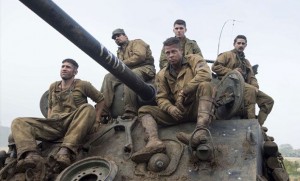 I wrote about Fury over at Christianity Today Movies and TV, I am tempted to simply link to that review and let it go at that. But since I need to cover a little space, I’ll add something that was cut from that review. Brad Pitt is the Hollywood movie star I would most like to hear try to do Shakespeare. His voice, more than his pretty face, is his primary instrument, and here he uses it to perfection. He can speak softly and still be discernible, and he can bark and still sound poetic. The alternating decibel levels are like the treble and bass of spoken music. Listen, I am not a big war movie guy. They tend to be one-note, even when they are done well, so I wonder if subjecting myself to the violence is worth whatever payoff I get in the form of genuine insight. Ultimately, I think Fury is a pro-war movie, but it is not afraid to give full throat to its counter-arguments. The result is a film that tallies the cost of war not just in the number of deaths but in the scope of dehumanizing degradation. Yet even as these men lose their tenuous grip on normalcy and decency, we are awed rather than repulsed by them. Occasionally we might find a good man to lay down his life for a friend, but what must it take to scar one’s soul to save another’s?
I wrote about Fury over at Christianity Today Movies and TV, I am tempted to simply link to that review and let it go at that. But since I need to cover a little space, I’ll add something that was cut from that review. Brad Pitt is the Hollywood movie star I would most like to hear try to do Shakespeare. His voice, more than his pretty face, is his primary instrument, and here he uses it to perfection. He can speak softly and still be discernible, and he can bark and still sound poetic. The alternating decibel levels are like the treble and bass of spoken music. Listen, I am not a big war movie guy. They tend to be one-note, even when they are done well, so I wonder if subjecting myself to the violence is worth whatever payoff I get in the form of genuine insight. Ultimately, I think Fury is a pro-war movie, but it is not afraid to give full throat to its counter-arguments. The result is a film that tallies the cost of war not just in the number of deaths but in the scope of dehumanizing degradation. Yet even as these men lose their tenuous grip on normalcy and decency, we are awed rather than repulsed by them. Occasionally we might find a good man to lay down his life for a friend, but what must it take to scar one’s soul to save another’s?
5) Selma — Ava DuVernay
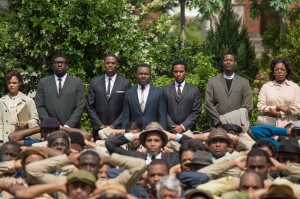 Perhaps the most refreshing moment in Ava DuVernay’s Selma is one in which nothing happens. After protesters have been gassed and beaten attempting to cross the bridge into Selma, Martin Luther King, Jr. puts the call out to white Americans, particularly clergy, to join the marchers on their next attempt. Bolstered by a strong turnout, he leads the protesters back to the scene of the crime only to hear the order for the police guarding the bridge to stand down. He kneels in prayer, and those of us not old enough to have lived through the event might be forgiven for being uncertain about what might happen next. Selma has all the conventional shots of beatings and rousing speeches that one would expect, but its strength is that it does not reduce the Civil Rights Movement to those moments. It takes the time to show us individuals relating to one another, since it understands that everyone conceives of himself first as an individual and only second as part of a movement. The film is careful to give recognition to white participants, which may help inoculate it against white-audience guilt fatigue. The performances are low key, with David Oyelowo portraying King as a quiet man with the weight of the world on his shoulders who uses his eloquence with great effect but sparingly and strategically. Round table interview with Wendell Pierce.
Perhaps the most refreshing moment in Ava DuVernay’s Selma is one in which nothing happens. After protesters have been gassed and beaten attempting to cross the bridge into Selma, Martin Luther King, Jr. puts the call out to white Americans, particularly clergy, to join the marchers on their next attempt. Bolstered by a strong turnout, he leads the protesters back to the scene of the crime only to hear the order for the police guarding the bridge to stand down. He kneels in prayer, and those of us not old enough to have lived through the event might be forgiven for being uncertain about what might happen next. Selma has all the conventional shots of beatings and rousing speeches that one would expect, but its strength is that it does not reduce the Civil Rights Movement to those moments. It takes the time to show us individuals relating to one another, since it understands that everyone conceives of himself first as an individual and only second as part of a movement. The film is careful to give recognition to white participants, which may help inoculate it against white-audience guilt fatigue. The performances are low key, with David Oyelowo portraying King as a quiet man with the weight of the world on his shoulders who uses his eloquence with great effect but sparingly and strategically. Round table interview with Wendell Pierce.
4) A Most Violent Year — J. C. Chandor
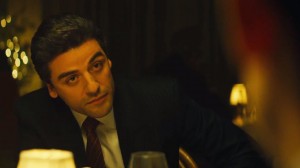 Abel Morales (Oscar Isaac) says that the key to success in life is that he has always chosen the path that is “most right.” Yet like his Biblical namesake, he is surrounded by people with other ideas about how to get what they want. I didn’t realize how good A Most Violent Year was until well after it was over, in part because I assumed through most of it that I knew exactly where it was going and how it was going to end. I didn’t. It is the early ’80s and Abel is fighting to survive and prosper in the heating oil business, an industry beset, we are told, with mobbed up bosses who would rather hijack trucks than work for a living. In the first act Abel leverages just about all he has to put a down payment on a property that will allow him to store heating oil in bulk and thus insulate his business from market fluctuations. Of course, complications ensue, and as the deadline to close on the deal or forfeit his earnest money draws near, the temptation to compromise morally and ethically, just a little bit, just this once, becomes seemingly unbearable. But is it? Abel is no saint, but when he resists temptation longer than not only most movie protagonists would but also longer than we think we ourselves could, his (in)actions make us question what we want in a hero and how deeply we are infected by our culture’s assumptions that force (i.e. violence) is the ultimate answer to all our problems. Finally, Oscar Isaac is on a roll. Yeah, it doesn’t hurt that he sort of vaguely resembles a young Michael Corleone. Michael, too, insisted that his deepest desire was to be different from the environment he was thrust into, to be–and to help his family to be–legitimate. We all know how that worked out, don’t we?
Abel Morales (Oscar Isaac) says that the key to success in life is that he has always chosen the path that is “most right.” Yet like his Biblical namesake, he is surrounded by people with other ideas about how to get what they want. I didn’t realize how good A Most Violent Year was until well after it was over, in part because I assumed through most of it that I knew exactly where it was going and how it was going to end. I didn’t. It is the early ’80s and Abel is fighting to survive and prosper in the heating oil business, an industry beset, we are told, with mobbed up bosses who would rather hijack trucks than work for a living. In the first act Abel leverages just about all he has to put a down payment on a property that will allow him to store heating oil in bulk and thus insulate his business from market fluctuations. Of course, complications ensue, and as the deadline to close on the deal or forfeit his earnest money draws near, the temptation to compromise morally and ethically, just a little bit, just this once, becomes seemingly unbearable. But is it? Abel is no saint, but when he resists temptation longer than not only most movie protagonists would but also longer than we think we ourselves could, his (in)actions make us question what we want in a hero and how deeply we are infected by our culture’s assumptions that force (i.e. violence) is the ultimate answer to all our problems. Finally, Oscar Isaac is on a roll. Yeah, it doesn’t hurt that he sort of vaguely resembles a young Michael Corleone. Michael, too, insisted that his deepest desire was to be different from the environment he was thrust into, to be–and to help his family to be–legitimate. We all know how that worked out, don’t we?
3) Siddharth — Richie Mehta
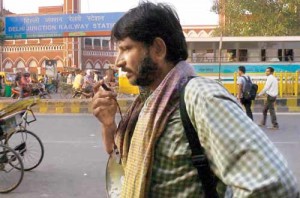 In my report from the D.C. Film Fest, I suggested Siddharth was like an Indian version of Taken minus the dad’s “special set of skills.” That sounds catty, but I honestly didn’t mean it to be. It was–and is–the quickest way I could draw attention to what I found extraordinary about Richie Mehta’s tragically undervalued drama: it takes a premise that is Hollywood through-and-through and imagines it set in the real world. Siddharth is about Mahendra, an Indian who ekes out a living as a “chain wallah.” He goes door to door and through the street picking up small change by fixing zippers. When he sends his twelve year-old son to work in an adjoining village, the film presents this action not as an atrocity of some unfeeling monster but as the capitulation of a poor man in the face of persistent want. Even when Siddharth doesn’t return home on the appointed day, Mahendra is slow to panic. It’s not that he doesn’t care, but a lifetime of counting every rupee has made him loathe to commit resources he doesn’t have for an emergency that probably isn’t one. When you hear hoofbeats…. Slowly panic does build, however, and if there were any doubts about Mahendra’s concern for his son, the second half of the film puts them to rest. Siddharth is one of the best films I’ve ever seen about poverty, because what it demands from its audience is not simply sympathy for the poor but an acknowledgement of their essential powerlessness. In one of the most oft-quoted lines from The Great Gatsby we are told a secret about the very”rich,” that “they are not like you and me.” Let me tell you a secret about the very poor. They are exactly like you and me–only with less money. We don’t like to think about that, because doing so makes us realize how very, very little security money can actually buy and how very, very much we chase after–and cling to–the wind.
In my report from the D.C. Film Fest, I suggested Siddharth was like an Indian version of Taken minus the dad’s “special set of skills.” That sounds catty, but I honestly didn’t mean it to be. It was–and is–the quickest way I could draw attention to what I found extraordinary about Richie Mehta’s tragically undervalued drama: it takes a premise that is Hollywood through-and-through and imagines it set in the real world. Siddharth is about Mahendra, an Indian who ekes out a living as a “chain wallah.” He goes door to door and through the street picking up small change by fixing zippers. When he sends his twelve year-old son to work in an adjoining village, the film presents this action not as an atrocity of some unfeeling monster but as the capitulation of a poor man in the face of persistent want. Even when Siddharth doesn’t return home on the appointed day, Mahendra is slow to panic. It’s not that he doesn’t care, but a lifetime of counting every rupee has made him loathe to commit resources he doesn’t have for an emergency that probably isn’t one. When you hear hoofbeats…. Slowly panic does build, however, and if there were any doubts about Mahendra’s concern for his son, the second half of the film puts them to rest. Siddharth is one of the best films I’ve ever seen about poverty, because what it demands from its audience is not simply sympathy for the poor but an acknowledgement of their essential powerlessness. In one of the most oft-quoted lines from The Great Gatsby we are told a secret about the very”rich,” that “they are not like you and me.” Let me tell you a secret about the very poor. They are exactly like you and me–only with less money. We don’t like to think about that, because doing so makes us realize how very, very little security money can actually buy and how very, very much we chase after–and cling to–the wind.
2) Beginning with the End — David B. Marshall
 Beginning with the End is a documentary about a group of high-school seniors who take an elective class in which they are trained to volunteer as hospice workers for the dying. It is compromised almost entirely of talk; there is not much to film in the small rooms where people linger in the remains of their days. And yet it is riveting. The film lets the emotions build gradually, softening rather than bludgeoning your heart. I mentioned in my SXSW review at Christianity Today that teens are one of the most stereotyped and criticized demographics in our culture. But I defy anyone to watch Marshall’s lean but leisurely sixty-four minute documentary and not feel better about the world we live in. The teens initially approach the dying with great fear. It isn’t the fear of dying, though, it is the fear of saying or doing the wrong thing and adding to another’s pain. Death strips us of so much of our pretense, and with it taken away, what is revealed underneath are hearts that long to be kind and that ache for connection. Marhsall shadowed two classes over two years, taking months to build relationships in order to earn the right to bring his camera onto holy ground and film his subjects in the most intimate circumstances imaginable. The result was something magical and rare. I love documentaries, but it is rare to find feel good stories among them. In a year in which Ivory Tower asked us to contemplate whether our educational system was fatally flawed and hopelessly broken, Beginning with the End reminded us that is is possible to instill and transfer values within an educational context. Kids are braver, smarter, and better than we think; sometimes we just need to stop teaching long enough to let them learn from life.
Beginning with the End is a documentary about a group of high-school seniors who take an elective class in which they are trained to volunteer as hospice workers for the dying. It is compromised almost entirely of talk; there is not much to film in the small rooms where people linger in the remains of their days. And yet it is riveting. The film lets the emotions build gradually, softening rather than bludgeoning your heart. I mentioned in my SXSW review at Christianity Today that teens are one of the most stereotyped and criticized demographics in our culture. But I defy anyone to watch Marshall’s lean but leisurely sixty-four minute documentary and not feel better about the world we live in. The teens initially approach the dying with great fear. It isn’t the fear of dying, though, it is the fear of saying or doing the wrong thing and adding to another’s pain. Death strips us of so much of our pretense, and with it taken away, what is revealed underneath are hearts that long to be kind and that ache for connection. Marhsall shadowed two classes over two years, taking months to build relationships in order to earn the right to bring his camera onto holy ground and film his subjects in the most intimate circumstances imaginable. The result was something magical and rare. I love documentaries, but it is rare to find feel good stories among them. In a year in which Ivory Tower asked us to contemplate whether our educational system was fatally flawed and hopelessly broken, Beginning with the End reminded us that is is possible to instill and transfer values within an educational context. Kids are braver, smarter, and better than we think; sometimes we just need to stop teaching long enough to let them learn from life.
1) Two Days, One Night — Jean-Pierre and Luc Dardenne
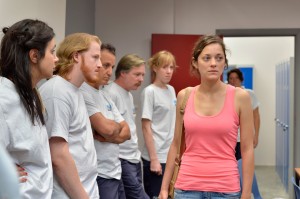 On one level, this is an easy choice. Who doesn’t like the Dardennes? When a new Dardenne film is announced, it’s not a question of whether it will end up on my Top 10 list, only a question of how high. But up until now, the Belgian brothers have never made a film that I rated my favorite. I wrote on Letterboxd: “It feels scandalous, maybe even blasphemous to talk about the Dardennes maturing, getting better, and yet I personally feel their last three films, rather than stopping at the moment of epiphany, have soldiered on into more complex narrative denouements that somehow avoid the inevitable conclusions you think you see coming.” What makes that especially true of Two Days, One Night is that the story of Sandra (Marion Cotillard) trying to convince her co-workers to forego a bonus so that she can keep her job presumably has only two possible endings. They will vote “yes” (in which case the film is a social fairy tale), or they will vote “no” (in which case it is a depressing and defeatist socialist lament). And yet the Dardennes always surprise me. As important as the outcomes are in the lives of their characters, Dardenne films always convince me that how they arrive at those outcomes–the choices they make along the way–are what’s eternally important. I believe that is why even though there is seldom any conventional religious talk in their films, the portraits they draw so exquisitely end up resonating deeply among the faithful. You can read my review from the Toronto International Film Festival at Christianity Today.
On one level, this is an easy choice. Who doesn’t like the Dardennes? When a new Dardenne film is announced, it’s not a question of whether it will end up on my Top 10 list, only a question of how high. But up until now, the Belgian brothers have never made a film that I rated my favorite. I wrote on Letterboxd: “It feels scandalous, maybe even blasphemous to talk about the Dardennes maturing, getting better, and yet I personally feel their last three films, rather than stopping at the moment of epiphany, have soldiered on into more complex narrative denouements that somehow avoid the inevitable conclusions you think you see coming.” What makes that especially true of Two Days, One Night is that the story of Sandra (Marion Cotillard) trying to convince her co-workers to forego a bonus so that she can keep her job presumably has only two possible endings. They will vote “yes” (in which case the film is a social fairy tale), or they will vote “no” (in which case it is a depressing and defeatist socialist lament). And yet the Dardennes always surprise me. As important as the outcomes are in the lives of their characters, Dardenne films always convince me that how they arrive at those outcomes–the choices they make along the way–are what’s eternally important. I believe that is why even though there is seldom any conventional religious talk in their films, the portraits they draw so exquisitely end up resonating deeply among the faithful. You can read my review from the Toronto International Film Festival at Christianity Today.
—
Ten very honorable mentions (in alphabetical ordern): DamNation; Force Majeure; Foxcatcher; The Homesman; I Believe in Unicorns; Jodorowsky’s Dune; The Overnighters; Snowpiercer; The Sublime and Beautiful; Supermensch.


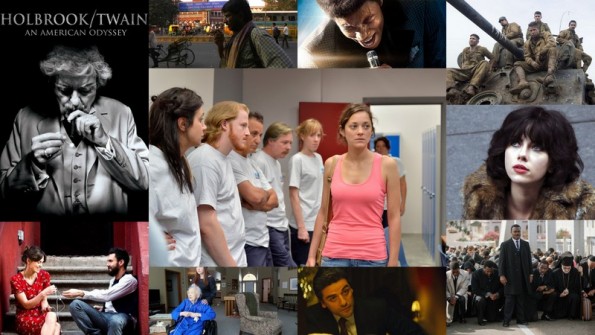
I’m holding off reading your list in detail until I’ve posted my own list (probably the first week in January). But scanning down, I think we’ll overlap on maybe one film (two if we count your Honorable Mention). It’s just been that good of a year for movies.
I agree that it has been a diverse and interesting year for films. As I mentioned on Facebook, there has been some chatter in wake of Sony hack about the trend towards more and more pre-sold, predictable content. But I had no comic book movies (though I enjoy them) on my list, no tentpole or franchise films, and no sequels. Good art is still getting made.
Leah Meyerhoff informs me via e-mail that I Believe in Unicorns will be distributed in Spring 2015 from Gravitas.
What, no Locke?
Hi Esther. I esteemed Locke (http://www.patheos.com/blogs/1morefilmblog/locke-knight-2014/), but it was not quite one of my favorites for the year.